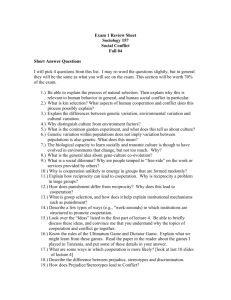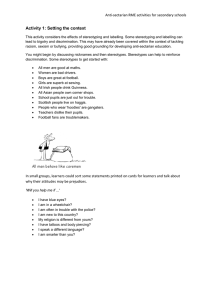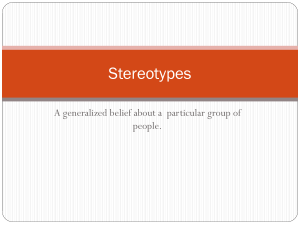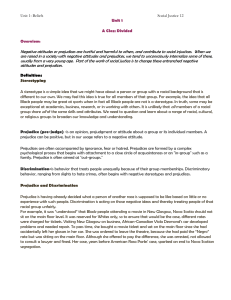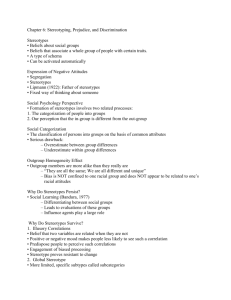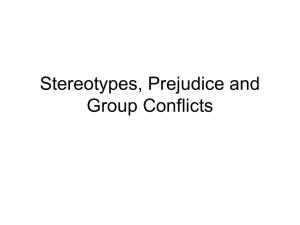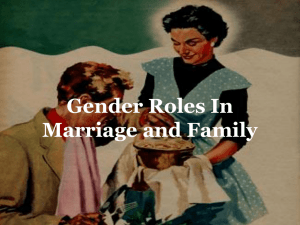getting-rid-of-prejudice-panaite-adrian1
advertisement
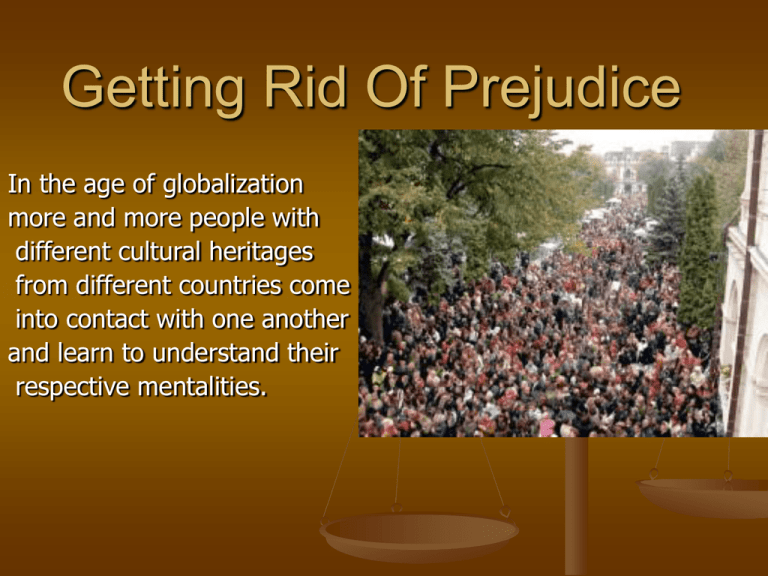
Getting Rid Of Prejudice In the age of globalization more and more people with different cultural heritages from different countries come into contact with one another and learn to understand their respective mentalities. Everyone has a certain image, some preconceived notions about each country and its inhabitants. But nowadays, being in the European Union gives us the opportunity to interact with citizens from different European countries and get to know them as they really are. Thus with increasing interactions we will learn to avoid stereotyping and our judgment of people will not be based on misconceptions. We will no longer be prejudiced against any nation and we will go beyond branding people according to categorization in order to learn more about each individual belonging to a given nation. Stereotypes are beliefs about the characteristics of groups of individuals and stereotyping is the application of these stereotypes when we interact with people from a certain group. Prejudice is a negative feeling or negative attitude toward the members of a group as a result of stereotyping. Stereotypes and prejudice are the result of the fact that we think about persons not as having their own personality or their unique features of character, but rather as being members of a certain group of people united by religion, nationality, age or gender. For example if you are a woman you belong to that emotional, somewhat irrational group of human beings, if your skin is darker you must be a Muslim, even if you are an Orthodox Greek, if you are over 70 years old young people brand you as senile. The most common prejudice is that women are housewives and men are the hard-working providers, who read the paper when they come home. Stereotyping occurs easily and people most of the time are not aware that they might be prejudiced against other persons. In order to get rid of prejudices we have to reduce the tendency to use stereotypes when judging others and also prove that stereotypes are false. The interaction of members of different groups will increase positive relations and create beliefs which are closer to the truth. The term ‘stereotype’ was very well defined by Walter Lippman, an American journalist, who in his book “Public Opinion” referred to stereotypes as the ‘pictures in our heads’ of the people in the groups around us. Prejudice goes farther than stereotypes – it involves a negative feeling or attitude toward the members of a group (Allport, 1954). In contrast with stereotypes, which involve thoughts or beliefs about a group, prejudice has an emotional component as well. It has been argued that everyone is prejudiced, but by intergroup contact we will get rid of prejudice and we will not be in danger of discriminating people. Common stereotypes and prejudices ROMANIANS are either vampires or gypsies. They are directly related to Dracula, they are perceived as being ingenious, trying hard but never succeeding, mistrust police and government, love to celebrate, stable and value-oriented, hospitable and friendly. Italians Italians are good at romance but bad at organizing things. They are perceived as passionate people, possessive, smooth-talkers, fashion addicted. GERMANS Germans are perfectionists, orderly and systematic, mechanical – born with a wrench in their hands; they love sauerkraut, follow blindly rules and regulations; they are seen as conscientious and rather cold. Portuguese The Portuguese are good sailors, but loud and adventurous. They are seen as kind rural people who love celebrations, well-travelled and nostalgic always longing for something, the term ‘saudade” often characterizing their mood. SPANIARDS Spanish people are bullfighters, temperamental, extroverted, impulsive, always late, flamenco dancers. They are also proud and patriotic, open-minded and the men look like Antonio Banderas. GREEKS Greeks are good architects, but think of themselves that they are powerful like their ancient gods; they always break their plates after meals. People see them as disorganized, cultured but inefficient, living the easy life. SWEDISH The Swedish are Vikings with fair hair and blue eyes, living in a perpetual winter. They are perceived as rational and bored, introverted, sophisticated and conscientious. Power Point Presentation created and presented in Baldham by the students of Technical Energetic College for the Comenius Project ‘Getting Along In Europe’ 2010-2012
